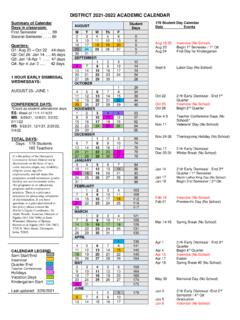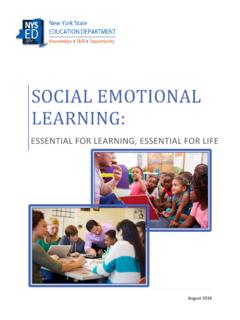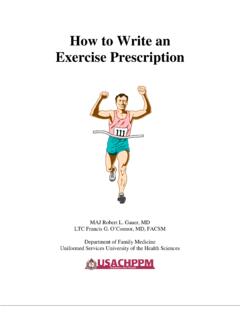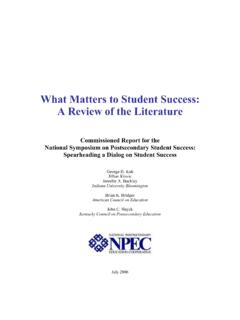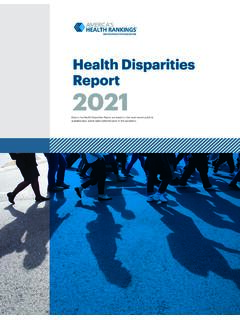Transcription of Using Data to Improve Educational Outcomes
1 Why Is Data Use Important?The use of data is a powerful tool to strengthen academic Outcomes for all students especially underserved students. Using data tells us whether certain groups of students have been disproportionately tracked into lower level classes or special education and whether or not they are proportionately represented in college-prep classes, honors or advanced placement courses, and other academic enrichment programs. Data disaggregated by factors such as race/ethnicity, English proficiency, income level, and disability status can lead to policies and practices designed to reduce dropout rates and Improve the quality of instruction for underserved students. Under the No Child Left Behind Act (NCLB) public school systems have assumed greater accountability and responsibility for tracking Outcomes and improving performance of elementary and middle school pupils.
2 With reauthorization of NCLB in 2007, it is likely that Using Data to Improve Educational OutcomesA College Readiness Issue Brief from the Pathways to College Networksimilar reporting requirements will be extended to high schools, which for the most part are currently required to report only annual graduation rates. Some schools and programs are already reaping significant benefits from Using data as a constructive tool to continually Improve student performance and to develop coherent instructional programs aligned with standards. But many more must follow if we are to make headway in closing the nation s chronic achievement gap between underserved students and all , only 60 percent of young people from low-income families can expect to graduate from high school; just one in three will enroll in college. A high school dropout is four times as likely to be unemployed as a college graduate and if employed will earn nearly 60 percent less than a peer with a college Statistics such as these, along with steadily increasing levels of knowledge and skills required for high-performance 21st century jobs, augur bleakly for those without postsecondary education.
3 In order to insure broad The Pathways to College Network developed this comprehensive conceptual Framework for Action to inform and support states, districts, schools, and programs in their efforts to prepare all students for success in college and the workplace. This series of issue briefs illuminates and provides resources on each of the five interrelated areas of the Framework: High Expectations, Academic Rigor & Support, Social Support, Data Use, and P-16 &SupportSocialSupportDataUseP-16 AlignmentInclusiveLeadershipFlexibleReso urcesCollaborativePartnershipsProfession alDevelopmentA Framework for ActionA Framework for Action 1with generous support from the GE Foundationindividual prosperity and national competitiveness in a global economy, it is imperative that far more of this country s many underserved students are prepared to succeed in Can Data Use Improve Educational Outcomes ?
4 Comparative data studies provide schools, districts, and states with opportunities to share best practices based on hard evidence. Data use informs teacher preparation and training needs, supports revised instructional practices to Improve student performance, and measures the effectiveness of ongoing academic and social support programs. Greater reliance on data has led some teachers to be more accountable to one another through collaborative school improvement work and reflective practice. Importantly, data have been used to challenge untested assumptions and beliefs about some students inherent on student achievement provide critical feedback to community stakeholders, parents, students, and teachers. There is a growing impetus in some schools and districts for creating longitudinal student record data systems as repositories of individual student histories.
5 These data can be used to Improve curricular alignment and student transitions throughout the P-16 pipeline by identifying important variables that impact students academic progress at key points along the way. Such data systems can also be rich informational tools to aggregate individual records for analysis at national, state, and district levels in order to inform policy, planning, and resource Types of Data Are Most Useful?Relevant school improvement data can be identified, collected, and analyzed within a number of broad categories that include: Demographic data: race/ethnicity, gender, income level, parents Educational level; Intra-school student data: school attendance patterns, courses completed, participation in after school programs and extracurricular activities, use of academic and social support services, AP participation and results; Classroom assessment data: classroom tests and observations, homework assessments, class projects, end-of-unit tests, end-of-course exams, course grades; Benchmarking data: national assessments, state high-stakes tests, district level assessments, SAT and ACT scores.
6 Outcomes data: teacher qualification/certification identifiers, drop-out and graduation rates, college participation rates; and Resource allocation data: instructional cost per pupil; academic support, extracurricular activities, and special programs expenditures. States, as well as schools and districts, will need to mount informational efforts for policymakers, educators, and other stakeholder groups to interpret data to Improve policies and practices. The National Governors Association has recommended that states adopt a student unit record data system with unique identifiers that can track individual students from kindergarten through postsecondary The Pathways to College Network urges integrated data systems to track the progression of students from middle school, through college, and into the workforce.
7 The recently established national Data Quality Campaign is a collaborative effort to encourage and support state policymakers to Improve the collection, availability, and use of high-quality education data to Improve student achievement. What Factors Hinder Effective Data Use?Although many national, state, district , and school leaders have increasingly come to recognize the value of Using evidence-based data to accelerate progress in closing our nation s persistent achievement gap, some significant obstacles remaining include:2 Using Data to Improve Educational Outcomes Use of data as a mechanism for criticism and blame, rather than a constructive strategy for school/program improvement; Lack of professional development or technical assistance for school/program leaders and practitioners to translate multiple measures and multiple levels of student achievement data into a realistic action plan for improvement; Insufficient capacity to develop evaluation strategies that appropriately connect and measure the effectiveness of action plans.
8 Limited common planning time for teachers/ program staff to work collaboratively in data teams; Change-resistant, less open organizational cultures that do not embrace collaborative efforts to use data to Improve practice; and Competing and conflicting demands that impede improvement initiatives from gaining traction and reaching What Actions Can We Take Now?Deliberate action at all stakeholder levels to use data-driven analysis for school improvement is required to close the achievement gap:Superintendents/ district Administrators Model the effective use of data as a foundation for continuous school improvement. Promote a culture of data-driven decision making to support school redesign and restructuring efforts. Develop an accurate and accessible longitudinal student information system; provide data tools and technical assistance to support fine-grained data analysis.
9 Collect data on individual students, including gender, race/ethnicity, special education status , English proficiency, socioeconomic status , and special program participation. Analyze data to identify best Educational practices; develop strategies for replication and implementation within the district . Use data to inform resource allocation; provide incentives for schools to use data to Improve policies and programs. Support professional development needs of school leadership teams to understand, analyze, and apply data. Principals/School Leaders Develop an evidence-based school culture reflecting a commitment to Using data for school improvement, decision-making, and resource allocation. Provide training for teachers and other school leaders on how to interpret individual, group, and year-to-year test scores and other effective data use.
10 Establish and support a broad-based school improvement data team to collect and manage data in accessible ways and to teach data literacy skills to others. Create a comprehensive data inventory that summarizes all types of data currently available. Develop data-based evaluative measures for assessing progress toward improvement goals. Teachers/Counselors Model an openness and willingness to use data to enhance teaching and learning. Use quantitative and qualitative data sources to Improve instruction and better understand student thinking and learning, including test results, portfolios, homework, student conferences, journals, classroom observations, and portfolios. Work collaboratively with other teachers and school leaders to develop documented patterns of evidence of student learning and to identify areas needing improvement.










